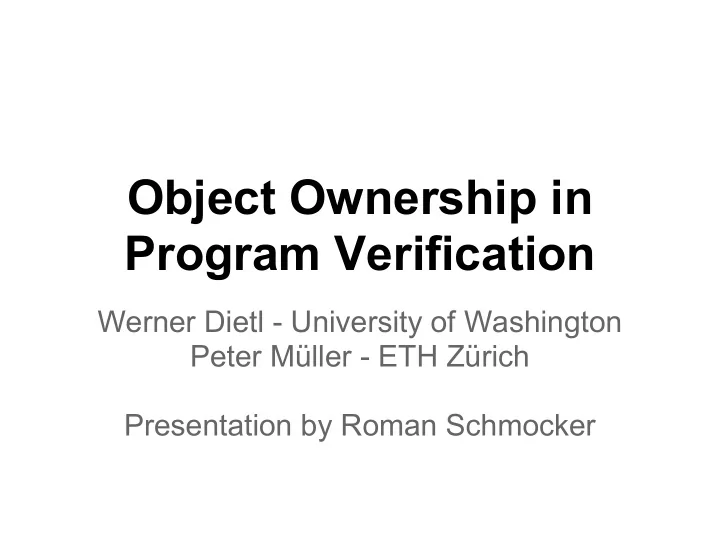

Object Ownership in Program Verification Werner Dietl - University of Washington Peter Müller - ETH Zürich Presentation by Roman Schmocker
Motivation
Object Ownership The basic concepts ● Goal: Information on Heap structuring ○ Reasoning about aliasing linked_list ● Ownership topology node node ○ Objects can own other objects ○ At most one owner ○ Enforced by language item item ● Encapsulation ○ Protect owned objects from arbitrary modifications ○ Write access only for the owner ○ Readonly or no access for others
Dynamic Ownership Ownership topology in Spec# linked_list ● Implicit ghost field: owner ○ Once set, cannot change node node ● Attributes on fields item item
Dynamic Ownership Ownership topology in Spec# linked_list ● Owner set automatically node node item item
Encapsulation ● Goal: Do not circumvent owner! ○ Write access needs "permission" of owner ● Object states ○ Valid: Invariant holds, read access ○ Mutable: Invariant can be broken, read/write access ○ Consistent: Valid, with mutable owner ● Encapsulation invariant ○ Never allow a mutable object with a valid owner!
Encapsulation ● Heap topology ○ Forest of ownership trees ○ Belt of consistent objects ● expose(o) { ...} ○ o becomes mutable Mutable within code block ○ only possible on Consistent consistent objects Valid
Encapsulation ● Mutating (impure) methods ○ Requires consistent receiver, argument, return value ○ Rationale: ■ May expose receiver ■ May call mutating methods on arguments ■ Caller should be able to modify return value ● Pure methods ○ Only requires valid receiver, argument, return value ○ Rationale: Not allowed to change values anyway
Example this n head tail
Example this n head tail
Example this n head tail
Example this n head tail
Example this n head tail
Example this n head tail
Applications Framing
Applications Framing ● Case 1: Shared node structures ● Case 2: a transitively owns b ● Case 3: a == b
Applications Framing ● Case 1: Shared node structures ○ No: contradicts topology invariant (only one owner) ● Case 2: a transitively owns b ● Case 3: a == b
Applications Framing ● Case 1: Shared node structures ○ No: contradicts topology invariant (only one owner) ● Case 2: a transitively owns b ○ No: Illegal call, since a and b cannot be both consistent ● Case 3: a == b
Applications Framing ● Case 1: Shared node structures ○ No: contradicts topology invariant (only one owner) ● Case 2: a transitively owns b ○ No: Illegal call, since a and b cannot be both consistent ● Case 3: a == b ○ No: see precondition
Applications Multi-Object Invariants ● Multi-Object Invariants ○ Invariants on state of referenced objects ● Problem ○ Objects may break the invariant of another object they didn't even know existed ○ Hard to check statically ○ A temporary break may actually be necessary
Applications Multi-Object Invariants ● Admissible Invariants ○ Only allow multi-object invariants on [Rep] objects ○ Objects can only break invariant of their owner ○ OK, since owner is mutable anyway ● Modular invariant checking ○ At the end of expose() block ○ At the end of constructor
Applications Immutable Objects ● Readonly interfaces ○ Can be casted away easily ● Wrapper classes ○ Make sure no mutable inner structure is leaked ○ Boilerplate code ○ (In Java:) Runtime checking, Exceptions ● Immutable objects ○ Only pure methods + constructor ○ Leaking still problematic ○ Inflexible object construction ○ Usually no inheritance allowed
Applications Immutable Objects ● Freezer object ○ Cannot be exposed ● Ownership solution ○ Just set owner to the Freezer!
Applications Immutable Objects ● Transitive for all owned objects ○ especially useful for data structures ● No boilerplate code necessary ○ Any object can become immutable ● Static checking ○ Inner structures safe from write access ● Allows complex initialization
Conclusion ● Provides encapsulation for object structures ○ Statically checked! ● Some nice applications ○ Interesting ones shown in talk ○ Further applications: Termination proof, data race freedom, effect specialization ● Little annotation overhead ○ But also less flexibility ● Possible to integrate in other languages
About the paper Historical Context ● 80s: Object-oriented programming emerges ○ Aliasing increasingly problematic ● 90s: Idea of Object ownership evolved ○ Most solutions inflexible and/or unsound ● 1998: Clarke et al: Ownership types ○ Flexible type system, soundness proven ● 2004: Microsoft releases Spec# ● 2012: This paper ○ Two implementations for Object ownership ○ Several applications
About the paper ● Assessment ○ Well written, self-contained ○ Many comparisons to other solutions ○ Main concepts actually come from another paper ● Current status ○ Dynamic Ownership implemented in Spec# ○ Framing and Multi-object invariants work ○ Freezing objects not implemented yet ○ Try it online: http://rise4fun.com/SpecSharp
Recommend
More recommend